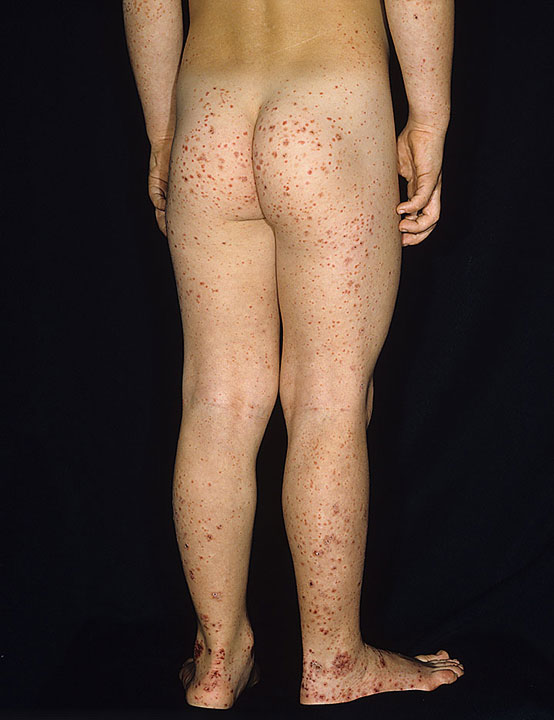Immunoglobulin A Vasculitis

A rare, small-vessel vasculitis characterized by skin purpura, arthritis, abdominal and/or renal involvement, IgA tissue deposits (arterioles, capillaries, and venules) and circulating IgA immune complexes.
Epidemiology
The disease usually affects children and is rare in adults. Annual incidence in children is estimated at between 1/4,880 and 1/6,660, whereas it is estimated at around 1/1,000,000 in adults. The male-to-female ratio is 1.5:1.
Clinical description
Patients present with vascular purpura that is usually symmetrical and primarily localized to the buttocks and legs. In adults it is more frequently complicated by necrotic or hemorrhagic bullous lesions. The lesions progressively regress, disappear after a few days and, in 80% of cases, never reappear. Patients also present with arthralgia, predominantly involving the knees and ankles. Abdominal pain is common and may be associated with life-threatening gastrointestinal bleeding. Renal involvement is more severe and frequent in adults. It usually consists of microscopic hematuria with varying degrees of proteinuria. Nephrotic syndrome, renal failure, and hypertension may also occur. Other manifestations are rare but may include headaches, seizures, paresis, orchiepididymitis, uretritis, pancreatitis, myositis, episcleritis, pulmonary bleeding and myocarditis.
Etiology
The disease is associated with deposition of IgA-dominant immune complexes in arterioles, capillaries, and venules, but the exact etiology remains unknown. Several different viral or bacterial organisms, drugs, foods, and insect bites have been implicated as the initiating factors of the disease.
Diagnostic methods
The diagnosis is based on clinical and histopathological findings. Examination of skin and kidney biopsies reveals tissue deposition of IgA with circulating IgA immune complexes.
Differential diagnosis
Differential diagnoses include other causes of purpura such as thrombopenia, hemopathy or infectious diseases. In adults, ANCA associated vasculitis, systemic lupus erythematosus, and mixed cryoglobulinemia should also be considered in the differential diagnosis.
Management and treatment
The treatment is symptomatic. The use of steroids and/or immunosuppressors is controversial but may be considered in case of severe gastrointestinal or renal manifestations. Renin-angiotensin-system blockers should be started as soon as the proteinuria/creatinine ratio is greater than 50 mg/mmol.
Prognosis
Gastrointestinal or pulmonary bleeding can be life-threatening. The long term prognosis depends on the extent of the renal involvement. Long term follow-up studies of adult series show that end-stage renal failure may occur in up to one-third of patients.